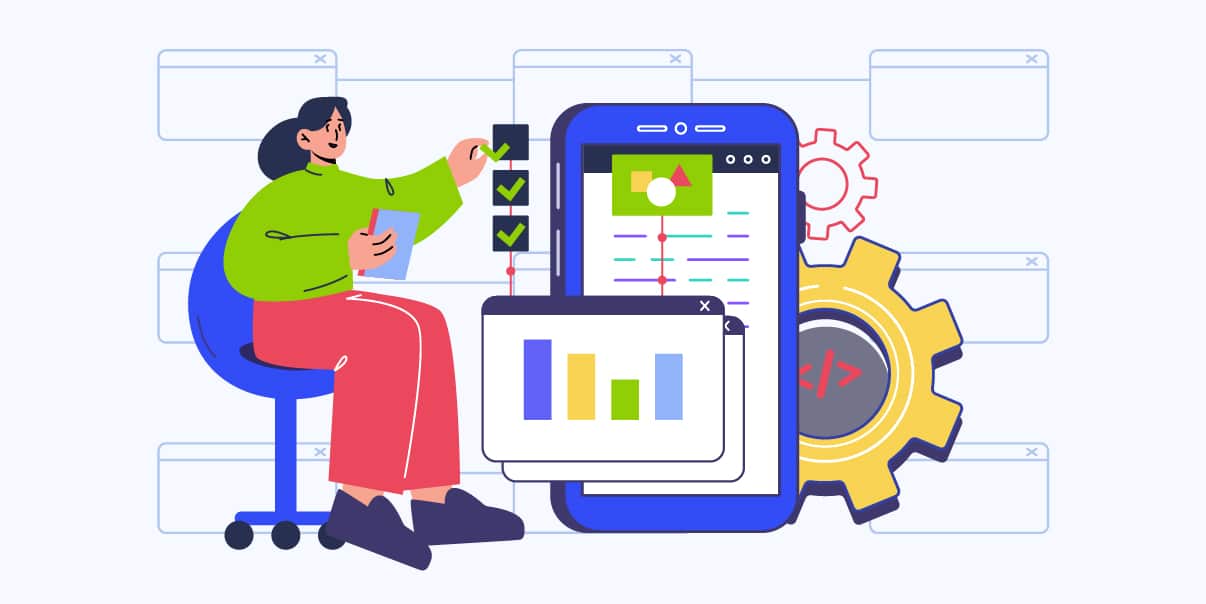The Complete Guide to Performance Testing Metrics

Performance testing metrics help you understand how well your application performs under different scenarios and conditions. From tracking speed to analyzing memory usage, several metrics give valuable insight into the performance of your code.
This guide will go over all the essential metrics used in performance testing, so you understand how they work and why they are crucial. Dive right in to get started!
What Is Performance Testing?
Performance testing is the process of evaluating an application’s performance and reliability in a variety of conditions. It involves running tests to analyze the program’s speed and responsiveness. You can also use performance tests to look for errors or security problems that may prevent the software from working correctly. These tests are essential for ensuring that your application is ready for use.
Moreover, performance software testing ensures that a computer, program, or website works as fast and efficiently as possible. It usually involves a developer trying out different scenarios with the program or website while measuring how long it takes to respond and carry out tasks. Performance testing helps identify any issues that could slow down the system’s overall performance.
Why Is Performance Testing Important?
Performance testing is essential because it helps us ensure that things run smoothly and efficiently. For example, suppose you have a computer program that needs to work quickly. In that case, performance testing will help you ensure that it can handle all the tasks it needs to do without slowing down or crashing. Performance testing also helps you identify potential problems before they become more significant. This way, you can fix them quickly and keep everything running like it should, now and in the future.
What Are Performance Testing Metrics?
Performance testing metrics measure how well a system performs tasks. They help identify problems like slow load times, bugs, and other issues. You can use a performance testing metric to measure the response or average load time to determine how quickly a website loads. You can also use performance testing metrics to measure user experience (UX). Just track the number of clicks it takes for users to find what the users are looking for on your site. Performance testing metrics give you valuable information about your system’s performance, which you can use to improve it.
What Are the Types of Performance Testing?
![What Are the Different Types of Performance Testing? [Infographics]](https://www.bitstudios.com/wp-content/uploads/2023/06/Performance-Testing-Metrics.jpeg)
Performance testing is a way to assess the performance of a system or application. It helps us identify how the application will perform in real-world environments and ensures that it meets certain user expectations. Performance testing involves different methods, including the following:
Load Testing
Load testing is a way to make sure that software, like websites, can handle a lot of people using them at the same time. It measures how an application performs under a specific amount of user traffic. Load testing helps developers know if their software can handle large numbers of people without crashing. It also finds potential problems that could arise when the system is overloaded.
Stress Testing
Stress testing ensures a computer or an online system can handle much work. To do this, you must push the system beyond its limits and see how it copes with extra pressure. Stress testing helps ensure it can still handle whatever demand you place on it, no matter how high.
Spike Testing
Spike testing is an experiment used to test a system’s performance or capacity limits. It sends more data or tasks to the system than usual, usually all at once. For example, your website usually gets 100 visitors a day. In that case, your spike test might call for 1000 visitors flooding in simultaneously. It will create unusual activities and loads that will strain the system and reveal any issues with its performance or capacity.
Endurance Testing
Endurance testing is a performance metric that measures how well a system or software can keep working over time. You can use it to evaluate a product’s or system’s reliability and whether it can withstand activities and tasks that take an extended period. For example, you are testing computer software. You want to see if the program can keep running without errors for a particular time.
Scalability Testing
Scalability testing ensures that a computer system can handle the demands of different kinds of users. This testing ensures that the system can scale up or down based on how much you use it. For instance, if lots of people are using a website at once, scalability testing can ensure that it will stay stable due to many requests coming in.
Volume Testing
Volume testing is a way of checking if a computer system can handle large amounts of data. It’s vital to ensure systems can handle the demands placed on them, especially when many people are using them at once. Also, it checks how quickly it can respond to requests and execute tasks. By running tests that simulate high-traffic situations, developers can ensure they prepare their systems for the expected workload.
Performance Testing Metrics to Track
Measuring performance metrics is critical to understanding how well your system is performing. By analyzing data such as average response time, peak usage, and error rate, we can gain insights into what needs to be improved and how to optimize our system.
The crucial performance testing metrics to track are as follows:
Response Time
Performance testing is a way to measure how well a computer system responds when given specific tasks. Response time is one of the testing metrics used in performance testing. It measures the time it takes for the computer system to respond when asked to carry out a task. Response time metrics can help identify problems with the system so you can address them. Suppose it takes a long time for a computer system to open a particular program or search for something on the Internet. In that case, response time can help determine why it happens.
Load Time
Load time measures how long an app or website takes to open. It’s vital because if an app or website takes too long to open, people might get frustrated and stop using it. Performance testing helps ensure websites load as quickly as possible so people don’t have to wait too long before they can access the content they need.
Throughput
Throughput is a crucial performance testing metric that measures how many operations you can complete within a given period. For example, when using a web service, you should know how many requests it can handle in one minute or one hour. Throughput helps tell us the speed of the system.
Concurrent Users
Concurrent users are the number of users or devices accessing a system simultaneously. You can use this metric to measure how well a system can handle large amounts of traffic at once and if it can maintain performance when needed.
Requests Per Second
A performance metric called requests per second (RPS) measures how many requests or tasks a computer system can handle in one second. It helps you understand what kind of workload your computer or software can handle, ensuring that the systems will be helpful and reliable for everyone who uses it. Also, it optimizes the performance of your computer systems.
Error Rate
The error rate is a standard metric used in performance testing. It measures how many errors occur when you test a system or how often something performs incorrectly or produces the wrong result. Additionally, error rate helps you determine when to make changes so that your software and machines will work better.
Transactions Passed or Failed
The metric transactions passed or failed measures the number of times a program could run from beginning to end without any errors. It’s also a way to know how many tasks you have completed out of all those attempted. Running a series of tests on a system will measure how many commands it can process and complete within a certain period. It’s essential to ensure the system performs at its best and carries out tasks in an efficient manner.
Bandwidth
Bandwidth is a performance testing metric that measures the amount of data you can transfer within a particular time. It helps gauge how you can quickly download a file or webpage. You can download large files in less time if the bandwidth is high because more data can travel through a larger pipe. If the bandwidth is low, it will take longer to download files.
What Is the Performance Testing Process?
Performance testing is a process used to measure the speed, responsiveness, and stability of software applications. It helps identify areas that need improvement or need more work so that the application can run better.
Here are the steps to an effective performance testing process:
Determine the Test Environment
To do performance testing, you must look at how well the product works in different environments. The test environment is the combination of hardware and software that you can use to simulate how the website or app behaves when it goes live. It includes operating systems, browsers, web servers, and databases.
Identify Performance Acceptance Criteria
Knowing the performance acceptance criteria is a crucial part of the performance testing process. It helps determine how well an application, website, or program performs. The performance acceptance criteria are the scores the system should meet for it to be successful. It includes how quickly the software or website loads, how many users it can handle, or if it looks good on different devices. It would be best if you met all these criteria to succeed in the performance testing process.
Plan and Design Performance Tests
Planning and designing multiple performance tests include choosing the right tools, setting testing scenarios, and creating data sets. It’s essential to have a well-thought-out plan so you can assess the performance of the system. Create one or two models with user variability, test data, and target metrics to measure the performance.
Configure the Test Environment
Configure your test environment with all the necessary data and settings needed for your tests. For example, set up a few sample products in your test database if you are testing an eCommerce website. And then, create some test accounts for customers so you can simulate how someone would use the website in real life. Finally, ensure everything is running smoothly and check that there are no errors or issues with the environment before starting the actual performance testing process.
Implement Test Designs
Test designs are the plans for setting up tests to ensure that a system can handle lots of tasks simultaneously without slowing down or stopping. You must design the course so your computer program or system gets tested on all the critical aspects of its performance. Doing so will help you decide which one is faster or more reliable.
Execute Performance Tests
This step involves running tests on the system to measure its performance metrics, such as response time, CPU utilization, and memory usage. The results will help decide if the system performs according to expectations or if there are any areas where you need improvements.
Analyze, Optimize, and Retest
The performance testing process also involves analyzing, optimizing, and retesting different aspects of the software to ensure it performs well in all situations.
Analyzing means looking at the data from previous tests and figuring out what needs to be improved.
Optimizing means changing something to make it run better. It could include changing the code, using different hardware, or editing settings.
Retesting is when you test again with your changes and see if they impact performance. If the changes did not improve performance, you would go back and try something else.
What Are the Best Practices in Performance Testing?
Performance testing ensures a software application works how it’s supposed to, especially under certain conditions. Developers must test their applications before releasing them so their users can have a good experience using the software.
The best practices of performance testing involve the following:
- Run tests on different hardware and operating systems
- Check response time
- Monitor its memory usage and disk space
- Evaluate user data
- Identify performance requirements
- Have a plan for each testing activity
- Set realistic and attainable test goals before beginning the testing
- Create detailed test cases that cover all potential scenarios.
- Allocate enough resources to complete the task on time.
- Verify the accuracy of data, functionality, and system configuration during all stages of the Performance Testing Life Cycle
- Analyze results to understand which parts of the application need improvement or optimization
- Re-evaluate processes and procedures regularly to ensure they are up-to-date with current best practices
These practices will help developers identify potential problems or bottlenecks, like CPU or memory utilization, to fix them before they cause user problems. Indeed, performance testing helps developers ensure their applications work well for all users.
Closing Thoughts
You can optimize your website or application for speed by utilizing the various key performance metrics. Indeed, performance testing metrics are essential for understanding the performance of a system. Studying these key performance indicators can help you know how well different areas of a system are working and identify any potential problems. You can also compare your current and past results to ensure the system performs at its best. With careful observation and analysis, key performance testing metrics are invaluable and ensure systems run smoothly and efficiently.
Ultimately, it’s up to you to choose which performance testing metrics best fit your system. By carefully evaluating the various tests, you can determine which ones suit your needs and create a plan for testing the system’s capabilities. With proper planning and execution, you can track the performance of your system through performance testing services and ensure its stability and reliability. Moreover, you can use these performance testing metrics to provide the best user experience possible.
Performance Testing Metrics FAQs
What Are the Best Performance Testing Tools?
Performance testing tools ensure the software works correctly. They help developers check if their products can handle a lot of users and measure how fast it responds.
One of the best performance testing tools is Apache JMeter, which allows developers to create test plans that simulate real-life user scenarios. It also has an extensive library of plugins that let you customize tests precisely for your project’s needs.
Another excellent performance testing tool is Gatling. It lets developers quickly build simulations for load-testing websites and APIs and comes with 3D graphs and reports so you can see clearly how the tests went.
Finally, Web Performance Test offers powerful features for web-based applications and mobile apps, as well as the automated recording of requests and support for load balancing.
What Are the Common Performance Testing Mistakes?
Performance testing ensures that a website, program, or system works correctly. But it can be simple to make mistakes when doing performance testing. Below are some of the common mistakes you should avoid:
Failing to Set Performance Goals
It’s crucial to define performance goals before you start testing. Having clear expectations will be easier to track progress and identify potential problems.
Avoiding Tracking Metrics
When testing, it’s essential to keep track of all relevant metrics, such as response time, memory usage, and bandwidth consumption. This data can help pinpoint any performance bottlenecks and give an overall picture of system performance.
Ignoring User Feedback
User feedback is essential to understand how you use a system. Feedback from users can tell you what types of tasks they are trying to accomplish and what areas need improvement.
Ceasing Automation
Automated tests can save a lot of time by running different scenarios without manual intervention. These ensure testing all aspects of the system regularly and accurately.
By avoiding these common errors, your performance testing should go much more smoothly. Also, learn from these mistakes so your network or system works as it should without worrying about anything.
When Should You Conduct Performance Testing?
You can perform performance testing anytime, but it’s best to do it when making a significant change to the system, like updating software or adding new elements. It helps to ensure that the system works as expected and functions efficiently. Also, it flags any potential issues before they become problematic.
It’s also important to conduct performance testing when releasing a new product or service. It ensures the system can handle all the expected load and meet customers’ expectations. You should regularly test your system if you have many users, as this helps identify any potential problems quickly and prevent them from arising.
Ultimately, the best time to test is before and after any significant changes to your system. This way, you can be sure that the system performance will be up to par and meet user expectations.
We’re BIT Studios!
At BIT Studios we specialize in designing, building, shipping, and scaling beautiful, usable products with blazing-fast efficiency



